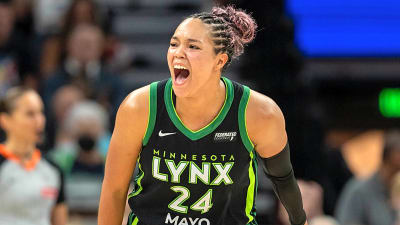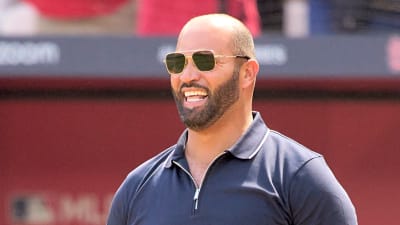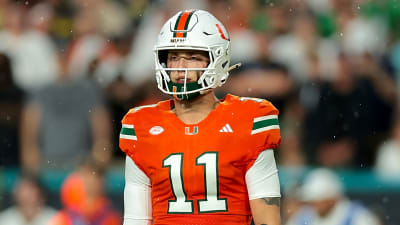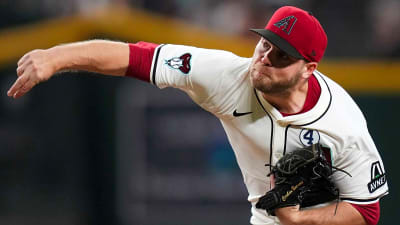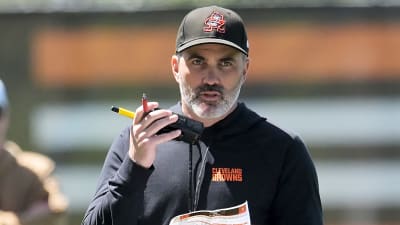
After the wild trade deadline for the Yankees, we saw over 10 prospects who were in our expected top 30 for August change organizations.
The MLB Draft did import multiple new additions, and there was room for some fun new additions to our top-30 list from inside the organization.
It’s been a great year for the farm system, which has seen players break out or rebuild their stock from a down year in 2024.
Graduating from the last list is Jorbit Vivas, with some near misses including Sabier Marte (hurt), Roderick Arias, Carlos Bello, Bryce Warrecker, Tony Rossi, and Alexander Almonte.
Without further ado; here’s the Empire Sports Media top 30 update for the Yankees’ farm system:
No. 30-21

30. Brando Mayea: OF
The Good: Brando Mayea displayed way more pop in his bat this season, hitting three home runs with four doubles and a triple in 20 games in the Complex League. His 140 wRC+ and .373 OBP were good signs in the results department, hopefully he continues to develop as he enters his 20s next season.
Room For Improvement: High groundball rates and poor contact rates hold me back from considering this season a roaring success for Brando Mayea. He did enough to stay on this list for now, but not enough for me to consider an aggressive rise on the list, and I seriously considered an omission from the list altogether.
29. Harrison Cohen – RHP
The Good: Harrison Cohen’s repertoire is headlined by a nasty changeup with tons of depth, sitting around 85-86 MPH with an esxtremely high whiff rate and chase rate. His fastball has good ride from a low release height which sets up the changeup at the bottom of the zone, and his cutter has become a really exciting pitch for him. These three weapons all have distinct movement profiles, and the command has taken steps forward as well.
Room For Improvement: The lack of overpowering fastball velocity could leave the pitch susceptible to damage contact against better competition in the big leagues. While the command is improving, strike-throwing can still be an issue at times for Cohen, who has a 58.8% Strike% and 13.6% walk rate in Triple-A. Relievers don’t have high ceilings which factors into the backend ranking as well.
28. T.J. Rumfield – 1B
The Good: We’re seeing T.J. Rumfield display more game power this year, with a 33-point improvement in ISO being a huge reason for his 138 wRC+ this season. His groundball rate is down by ~10% and he’s pulling the ball more as well, all signs that his bat could hold its own at the Major League level. Rumfield is also well-regarded as a defender at first base, winning a Minor League Gold Glove in his time with the organization.
Room For Improvement: The raw power is still underwhelming, which does create a concern about how much value he’ll ultimately produce at the Major League level. First basemen depend on their power and offense a lot to generate value to their ballclub, and there aren’t many successful players at the position who have below-average exit velocity numbers. His chase rates are high as well, so while he does make contact, the OBP could end up being unimpressive.
27. Kyle Carr – LHP
The Good: Kyle Carr rarely gets barreled up, possesing a groundball rate over 52% and a HR/9 of just 0.57 on the season with the Hudson Valley Renegades. He’s got a fastball, cutter, sinker, and slider which allow him to miss barrels and keep hitters from squaring his pitches up. Carr doesn’t throw hard he’s crafty enough to make it work. He has a 2.25 ERA in 27 starts at the High-A level since the All-Star Break last season.
Room For Improvement: The Yankees promoted Ben Hess before Kyle Carr despite a massive difference in run prevention, an indication that they see what I see as well. The lack of whiffs paired with a lot of walks are a concern that hasn’t gone away, and he’ll need to continue improving in that regard to head up to Somerset. He has an 18.8% K-BB% and 25.6% K% in his last six starts, hopefully that’s a sign that he’s making some strides in that regard.
26. Queni Pineda – C
The Good: Queni Pineda displayed elite plate skills this season, walking 19 times to just 12 strikeouts in 20 games as he posted a 129 wRC+ as an 18-year-old in the DSL. While his OPS dropped from last year, his contact rates saw a massive improvement and I believe there’s upside for him to be a solid hitter in the system. Defensively, Pineda has an impressive skillset and threw out 32% of runners who attempted to steal against him last year. Always keep an eye on catchers inside the Yankees’ system.
Room For Improvement: The game power worsened as the walk rates and contact rates increased, while his current profile is far more sustainable for success, I’d like to see that aggressive pull-side swing return. Pineda is also repeated the DSL level, so those adjustments are hard to fully buy into without seeing results against better competition, prospects at this level are impossible to project.
25. Richard Matic – 3B
The Good: Richard Matic dominated the Dominican Summer League as a 17-year-old, picking up 19 XBHs with a .503 OBP and 177 wRC+ in 41 games. His contact rate improved by over 13% from last season while decreasing his groundball rate by nearly 10%, and he looks ready for a promotion to the Complex League next summer. Matic is a patient hitter who has good pull-side power, traits that should project well as he continues to grow into his frame.
Room For Improvement: The athletic profile is very limited, he’s already at third base and doesn’t provide much on the bases when he attempts to steal or be aggressive. This might be a bat-first prospect as a teenager, which makes you wonder what it’ll be when he’s older and gets slower in his mid-20s. Not every good prospect is fast, and being a good defensive third baseman is valuable, and being a teenager gives him room to grow and refine his game.
24. Dylan Jasso – 3B
The Good: It’s hard to argue with a 140 wRC+ at the Double-A level, as Dylan Jasso has 13 home runs, 15 doubles, and six triples with the Somerset Patriots. He makes a good amount of contact and most of it is in the air, resulting in plenty of base hits and some exciting game power as well. Jasso has a 79.3% Contact% and 8.3% Swinging Strike Rate at a level he never played before entering 2025, and his knack for hitting the ball to right field will help him as a righty in the Bronx.
Room For Improvement: Finding a defensive home for Dylan Jasso has been tough, and if he ends up as more of a first baseman, that seriously hurts his overall ceiling. His below-average walk rate is also a result of some not-so-great swing decision which is a concern for his ability to hit pitching at the Major League level. He has shown progress at third base, but the glove remains a real worry for his WAR projections.
23. Core Jackson – SS
The Good: Core Jackson has displayed an exciting combination of power and contact, hitting a baseball 114 MPH, which at the shortstop position is pretty eye-catching. He’s an aggressive baserunner and has displayed a pretty electrifying playstyle, and that left-handed swing could perform brilliantly at Yankee Stadium. He’s an interesting selection in the 5th Round for the Yankees, and as a college bat he could be in High-A next Spring.
Room For Improvement: The will-he-won’t-he for college shortstops and their ability to play said position at the MLB level will also hover over Core Jackson’s head. An 18% strikeout rate and 8.8% walk rate at college doesn’t stick out either, so I project a medicore K-BB rate for the left-handed bat.
22. Rory Fox – RHP
The Good: Rory Fox has an excellent fastball shape from a low release height, sitting around 92 MPH with room to add some more under pro instruction. His changeup has tons of vertical separation off the heater, and his ability to spin a tight slider and slow curveball on top of that is impressive. If the Yankees can get Fox to expand his repertoire a bit more, we could be looking at a backend starter at the Major League level.
Room For Improvement: The current lack of fastball velocity paired with a slider that lacks the velocity to be effective against higher levels of competition are hurdles he has to climb. Even if I project improvements, they currently haven’t been implemented and that affects my scouting. Furthermore, Fox didn’t miss a ton of bats in college, which means he has plenty of work to do with the Yankees this offseason.
21. Brendan Beck – RHP
The Good: The Yankees have seen Brendan Beck go from oft-injured arm who had lost his prospect stock to a solid prospect who can fill-in as a backend starter if something goes wrong injury-wise. Beck possess a low-90s fastball with elite vertical movement, pairing it with a deathball slider that gets tons of whiffs and a slow curveball that can freeze hitters for strikes. His command is a huge calling card, and he should be protected on the 40-man this winter (or traded before the Rule 5 Draft).
Room For Improvement: Brendan Beck has an extremely limited ceiling due to the poor velocity, it’s hard to see him pitching every fifth day as a middle-of-the-rotation starter for that reason. He has given up a ton of home runs in Triple-A because of how hittable his pitches are when he misses in-zone, and an extensive injury history will only create more uncertainty around his profile.
No. 20-11

20. Jace Avina – OF
The Good: Jace Avina’s game power is strong, with 10 home runs and 17 doubles in 69 games between High-A and Double-A as a 22-year-old. He’s made more contact since his promotion to Double-A with good walk rates, and the presence in the batter’s box has really excited me this season. I hope he can stay healthy and continue displaying this well-rounded approach for an extended period of time, he’s on a pretty exciting trajectory right now.
Room For Improvement: I originally believed Avina would be a centerfielder, but he’s played more corner outfield this year and that does hurt a bit of his ceiling. Furthermore, he hasn’t shown much on the bases to suggest that he’ll add much value outside of the bat offensively. Injury risk is high, but I’m keeping a close eye on how he finishes this season.
19. Mani Cedeno – SS
The Good: Mani Cedeno really struggled in the DSL, but at 16 years old, it’s hard for me to be too harsh on his play right now. I’ll give him the benefit of the doubt and let him play out a second season before seriously dropping his stock, as he has good athletic tools and could actually stick at the shortstop position. He displayed excellent speed with 20 steals in 42 games, and hopefully he grows into his body more over the offseason.
Room For Improvement: There’s not a lot to get out of a 35.3% K%, .077 ISO, and .182 average. You don’t see much in the game power, contact rates, or hit tool to be happy about right now, and unfortunately that’s been the case with a lot of IFA bats recently for the Yankees. You’ll see a lack of DSL hitters on this list for a reason.
18. Pico Kohn – LHP
The Good: Pico Kohn’s fastball is one that excites me, the lack of velocity (~92 MPH) is a buzzkill to some but his funky release paired with elite vertical movement makes it a plus pitch. He also consistently locates it near the top of the zone, maximizing its whiff potential which is exciting if he can add some velocity under pro instruction. The slider he has possesses more gyro movement with sharp action that gets whiffs off of the heater, there’s definitely a solid foundation here.
Room For Improvement: Kohn used his fastball over 60% of the time and his slider was his only reliable secondary pitch, so the Yankees need to help him add more to the repertoire. His velocity needs to improve even if I think there’s room to grow before I can rank him higher on this list, but I could 100% see him leaving the Yankees’ development camp in Tampa and becoming a top 10 prospect in the organization in 2026.
17. Kaeden Kent – SS
The Good: Kaeden Kent has such a well-rounded approach at the plate with an ability to launch the ball to right field, take his walks, and make a healthy amount of contact. The offensive profile is one I’m super excited about because if he can take to the Yankees’ hitting development program well, the raw power could improve and he could be a fast-riser inside the organization. The defensive versatility will help as well, since he can play multiple infield positions (including first) and might have some outfield versatility.
Room For Improvement: Defensively, I don’t know if Kaeden Kent is a full-time shortstop, I think he has some Oswaldo Cabrera traits on that side of the ball where he can play it in a pinch but shouldn’t start there every day. That tool can still develop, but I also do have some questions about any prospect who profiles in the jack-of-all-trades bucket since it could lead to a lot of 40-45 tools instead of 50-55s when you move up the professional ladder.
16. Brock Selvidge – LHP
The Good: Brock Selvidge is healthy and has a good ability to spin breaking balls, those are two things that are key to him having any success at this point. His fastballs leave a lot to be desired but the arsenal does have four distinct pitches which helps him with a fastball, cutter, sweeper, and curveball all at his disposal. Even if his command never goes back to where it was pre-surgery, Selvidge could end up in a reliever role and perform admirably I believe.
Room For Improvement: Until the command comes back, I simply cannot view him as a reliable starter in the organization and more importantly, he won’t be generating many whiffs. He doesn’t have the dominant velocity (90-92 MPH) to overcome poor control, and if the Yankees don’t see improvements there in 2026, the stock will fall further.
15. Allen Facundo – LHP
The Good: Allen Facundo’s fastball velocity has shot up, touching 99 MPH a couple of times and sitting around 95 MPH on his four-seamer. His signature pitch is his slider, which is wicked with good two-plane movement in the mid-80s that has a whiff rate over 45%. The stuff creates a high ceiling, and at just 22 years old coming off of elbow surgery, he could be promoted to High-A before the season is over.
Room For Improvement: Right now, Facundo has just three pitches with a slider, four-seamer, and two-seam fastball that can get whiffs or soft contact. He profiles more as a reliever with that kind of arsenal, and it’ll need to expand in order for him to move up further on the list.
14. Brendan Jones – OF
The Good: A gritty outfielder who came out of college with a great reputation on the bases and with his glove, Brendan Jones has adapted to the modern game beautifully since being drafted by the Yankees. He’s swinging more aggressively while maintaining strong contact and strikeout rates at the Double-A level, slugging .452 with seven home runs and a .205 ISO in 48 games at Somerset. His .350 OBP and 33 stolen bases make the Brett Gardner comps really shine; the parallels are quite shocking in their swings.
Room For Improvement: Brendan Jones lacks the incredibly-high ceiling that would permit a higher ranking on this list. He’s a suped-up version of Caleb Durbin as a prospect, which isn’t a bad thing considering how he’s produced for the Brewers, but that kind of player won’t get MVP votes and profiles for more of that situational or bench kind of role.
13. Cade Smith – RHP
The Good: Cade Smith returned after a lengthy stint on the injured list, displaying similar velocity to what we saw last season with good vertical movement and his lower release height. The heater hasn’t missed a ton of bats, but his slider is one of the best breaking balls in the organization and there’s room for him to continue expanding the arsenal. Smith may not reach Double-A until next year, but his stuff is above-average and I think there’s room for growth as a pitcher.
Room For Improvement: The lack of whiffs right now feel like a post-injury rust he has to shake off, but his command has been a bit of a hinderance for him early in his pro career. They present a real reliever risk for the right-hander, who also doesn’t have a sharp enough repertoire beyond the fastball-slider to overcome the location struggles.
12. Dillon Lewis – OF
The Good: This is Dillon Lewis’ debut on my top 30, and it’s a well-deserved one given just how much power he has in the bat and how much refinement we’ve seen at the plate. He’s improved his contact and strikeout rates a good bit since being promoted from Single-A to High-A, and the game power is still excellent. Lewis has displayed 70-grade raw power, has excellent speed, and can hold his own in centerfield defensively, the upside here is immense.
Room For Improvement: Lewis still struggles to work walks and get on-base, reflected in his .303 OBP with Hudson Valley in 48 games. The bat path is also a work-in-progress, his groundball rate is up by almost 5% since the promotion and the line drive rate has seen a steep decline.
11. Thatcher Hurd – RHP
The Good: At LSU we saw an arsenal that has the potential to materialize into an effective big-league starter, having a big fastball with tons of ride and good velocity. His slider is a good pitch that blends above-average velocity with good two-plane movement, and his athletic delivery makes me wonder what he could be under pro instruction. The ceiling is high, and I think even if he fails as a starter he would make for an explosive reliever at the big-league level/
Room For Improvement: Rehabbing from a UCL tear, we will likely not see Hurd until the tailend of the 2026 season, a true shame considering he was a prospect I held in high regard out of the draft. There’s a lot of upside, but now you have to worry about how his fastball will look post-surgery and whether his already poor command will get even worse when he makes his pro debut.
No. 10-1

10. Chase Hampton – RHP
The Good: When healthy, Chase Hampton has elite fastball shapes, two excellent slider shapes, a reliable curveball, and a changeup that’s a work-in-progress. His command has made strides with the Yankees, and there was a real point in time where it felt like he would be taking the ball in a playoff game as a starter for the organization.
Room For Improvement: Injuries continue sapping away at Chase Hampton, and you wonder if the fastball velocity will end up taking a big hit after the Tommy John Surgery. Not everyone comes back the same. It’s such a shame considering how good he was in 2023.
9. Henry Lalane – LHP
The Good: We’re seeing Henry Lalane’s velocity slowly creep up after last year he sat at around 90 MPH, and it’s also coming with a solid shape given his lower arm angle. The changeup shape looks great as well, and the slider has more of a distinct sweeper shape that should give him a foundation to work with there. I thought he was destined for a top-100 spot after 2023, and while he hasn’t lived up to that high upside to this point, he’s still got time to rebuild value.
Room For Improvement: The aforementioned slider is still far from a perfect pitch, I’m not convinced that can be an effective weapon at the big-league leverl when its sitting around 75 MPH. He’ll need to continue adding more velocity and figuring out that reliable breaking ball so he can have a more well-rounded repertoire. The command is also a work-in-progress, and you always have to worry about his health. The ceiling is there, but that floor is low.
8. Dax Kilby – SS
The Good: Dax Kilby has an elite ability to make contact, he doesn’t whiff often and absolutely despises striking out, which has sharpened his eye at the plate as well. You’re getting a patient hitter who knows when to attack and will make solid contact when doing so, and his speed can make him a threat on the bases as well. This is a prototypical lead-off hitter profile, and his left-handed swing could do very well at Yankee Stadium with the right adjustments.
Room For Improvement: Improving the power tool will be a must in order for Kilby to become the everyday starter that the Yankees hope he can be. I also think the glove needs work in order to stick at shortstop, there is real belief that he’ll end up moving to a different position, but I also remember when Anthony Volpe was labeled as a second baseman and Austin Wells a corner outfielder before they reached the Major Leagues.
7. Bryce Cunningham – RHP
The Good: A well-rounded pitcher who has the foundation of a reliable no. 3-4 starter, Bryce Cunningham has a good fastball at 93-95 MPH with tons of extension of vertical ride. He pairs it with a power changeup and sharp slider, pitches that allow him to keep the ball on the ground and generate a healthy number of whiffs. The command is sharp, his delivery is smooth, and the tall bulky frame gives him a real pitcher look.
Room For Improvement: A shoulder injury has kept him out for months, and it’s allowed other prospects in the system to jump him in my prospect rankings. I would consider him in the same tier as the prospects ranked from 2-6, but he’ll have to come back with the same velocity to leapfrog his fellow NYY prospects. Another issue he has is that, like Ben Hess, he has a shallow repertoire, so there’s work he’ll need to do when he does return in order to consistently get advanced hitters out.
6. Ben Hess – RHP
The Good: After sitting between 90-93 MPH with the occassional 95 MPH heater, Ben Hess has seen a velocity uptick, sitting closer to 93-94 while hitting 96-97 routinely during starts. His fastball has elite vertical movement relative to his release height, and the changeup he’s learned with the Yankees has a ton of movement. I love the curveball, and the 2024 first-round pick is trending in the right direction after a shaky start to his pro career.
Room For Improvement: Command can still be an issue for Hess, who has improved in that regard but still has ways to go before killing some of the reliever risk attached to him. I also think the lack of a deep arsenal could hurt him, there’s more he needs to unlock in his mix whether it be adding another reliable fastball shape or honing that sweepy breaking ball I hinted at earlier.
5. Spencer Jones – OF
The Good: No one in Minor League Baseball has more game power than Spencer Jones, who has taken that tool from a ~55 to a true 70+ tool in just one offseason. Few hitters can hit the ball in the ways he can, and if we can continue to see the contact improvements that he’s displaying at the Triple-A level, he could be a legit middle-of-the-order bat. It also helps that he’s a premium basestealer with good defense at a position like center field.
Room For Improvement: Spencer Jones still has a lot of whiff issues, but my primary concern at this point is that he chases a lot out of zone, which could prevent him from having a high OBP. It’s hard to be an above-average hitter who has a median K% above 30%, but that’s even harder when your walk rate could be below-average as well, so he’ll need to continue sharpening his plate skills to be a true impact bat.
4. Elmer Rodriguez-Cruz – RHP
The Good: A combination of plus stuff and excellent arsenal depth allow Elmer Rodriguez-Cruz to attack the zone and find plenty of success doing so. He has a strong sinker with excellent groundball rates, nasty breaking balls with good whiff rates, and an emerging splitter that could be the equalizer for him. Cruz has seen his strike-throwing improve since his promotion to Double-A, and there’s a steady middle-of-the-rotation ceiling here.
Room For Improvement: ERC still has a walk rate nearing 10%, and the Yankees will need him to continue improving as a strike-thrower if they want him to be that rotation piece they hope for. His arsenal doesn’t have any glaring weaknesses, even if he ends up in the bullpen I think he’d be pretty effective in that role.
3. Carlos Lagrange – RHP
The Good: You cannot hit this guy if he’s attacking the zone. The stuff is monstrous, his heater has good shape and triple-digits velocity, he sports a big sweeping slider and a firm gyro slider, and also has developed a disgusting changeup with insane whiff rates. Carlos Lagrange is the definition of a boom-or-bust starter, the Yankees have a potential ace on their hands if the command is even remotely average.
Room For Improvement: While untouchable when attacking the zone, Lagrange has seen his walk rate balloon to over 16% in Double-A due to inconsistent strike-throwing. He needs to find more consistency in the zone or else he’ll end up a reliever (which is fine), and I currently project a bullpen role for him because of it.
2. Cam Schlittler – RHP
The Good: Cam Schlittler has displayed a power fastball with improving shape, slowly making it one of the better fastballs in the organization. The leap in both velocity and shape is shocking, and he pairs this pitch with a sharp cutter, unique sweeper, and hammer curveball. His overpowering stuff and elite spin rates leave room for him to continue expanding the repertoire, and Schlittler has legitimate frontline starter upside.
Room For Improvement: The lack of sharp command leaves Cam Schlittler vulnerable to damage contact, he tends to leave a breaking ball up or lean on his fastball too much out of mistrust. He’ll need to hone those secondaries to avoid walks and home runs, and I also believe adding something that moves in on righties and away to lefties would help keep hitters off-balance as well.
1. George Lombard Jr – SS
The Good: A smooth-fielding shortstop with brilliant speed, George Lombard Jr. will generate quite a bit of value outside of his bat when he reaches the Major Leagues. He’s also displayed brilliant plate discipline, resulting in a .365 OBP and 14.8% walk rate between High-A and Double-A this season. Lombard is only 20 years old, there’s still time for him to both grow and mature offensively into a potential lead-off hitter at the Major League level.
Room For Improvement: His lack of game power is still a real issue, the ISO (.132) is below-average even if it’s better than where it was at last season. The low swing rate could be hindering his ability to crush the baseball and catch a pitch out in front, and if George Lombard Jr. wants to become a star, he’ll need to find his power swing.
More must-reads:
- MLB playoff takeaways: AL home teams rise up to force decisive Game 3s
- Angels to interview future Hall of Famer for managerial vacancy
- The 'Active 30-homer MLB seasons leaders' quiz
Breaking News
Trending News
Customize Your Newsletter
 +
+
Get the latest news and rumors, customized to your favorite sports and teams. Emailed daily. Always free!
